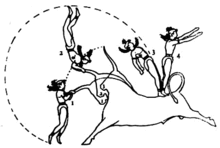| Bull-Leaping Fresco | |
|---|---|
| Greek: Ταυροκαθάψια (Taurokathapsia) | |
 | |
| Artist | Unknown |
| Year | 1450 BC |
| Type | Fresco |
| Medium | Stucco panel with scene in relief |
| Dimensions | 78.2 cm × 104.5 cm (30.8 in × 41.1 in) |
| Location | Heraklion Archaeological Museum, Heraklion, Crete |
| Owner | Hellenic Republic |
The Bull-Leaping Fresco is the most completely restored of several stucco panels originally sited on the upper-story portion of the east wall of the Minoan palace at Knossos in Crete. It shows a bull-leaping scene. Although they were frescos, they were painted on stucco relief scenes. They were difficult to produce. The artist had to manage not only the altitude of the panel but also the simultaneous molding and painting of fresh stucco. The panels, therefore, do not represent the formative stages of the technique. In Minoan chronology, their polychrome hues – white, pale red, dark red, blue, black – exclude them from the Early Minoan (EM) and early Middle Minoan (MM) Periods. They are, in other words, instances of the "mature art" created no earlier than MM III. The flakes of the destroyed panels fell to the ground from the upper story during the destruction of the palace, probably by earthquake, in Late Minoan (LM) II. By that time the east stairwell, near which they fell, was disused, being partly ruinous.
The subject is common in Minoan art, one of a number depicting the handling of bulls. Arthur Evans, Keeper of the Ashmolean Museum, owner of the palace and director of excavation, presents the topic in Chapter III of his monumental work on Knossos and Minoan Civilization, Palace of Minos. There he calls the several frescos "The Taureador Frescos."[1]
There are more fragments than are included in the famous reconstruction, and it is generally thought that there were several bull-leaping scenes. A proposed reconstruction by M. Cameron has four very similar scenes, each with a left-facing bull and three human figures, one upside-down over the bull's back, and then one at each end, the ones at the front holding the bull's horns.[2]

- ^ Evans 1930, p. 203.
- ^ Marinatos, Nanno (1993), Minoan Religion: Ritual, Image, and Symbol, 67-69, 1993 Columbia, SC: University of South Carolina Press.